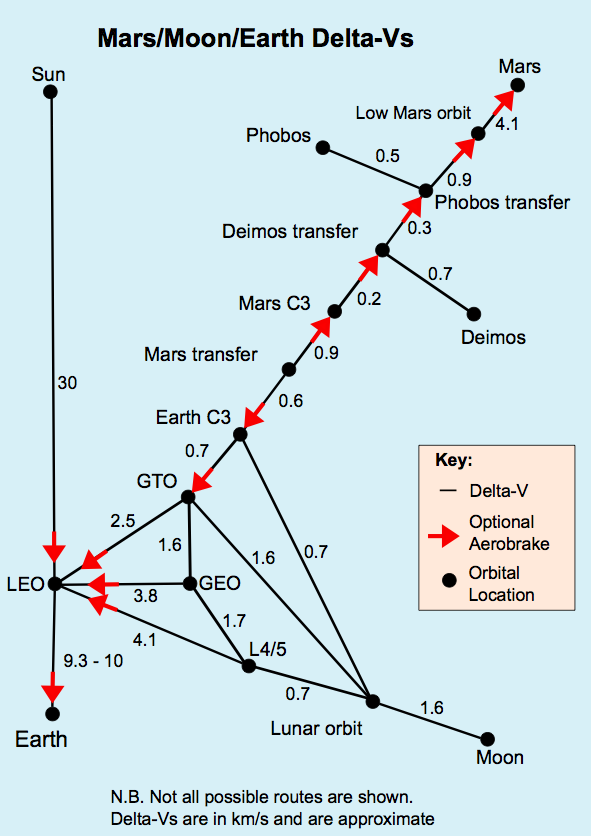RGClark
Mathematician
- Joined
- Jan 27, 2010
- Messages
- 1,635
- Reaction score
- 1
- Points
- 36
- Location
- Philadelphia
- Website
- exoscientist.blogspot.com
Key points about a propellant depot based Mars architecture, once the propellant depots are in place at both departure and arrival points:
1.)One single medium-lift booster first stage, Falcon 9, Atlas V, Delta IV, etc., delivered empty to orbit can then do ALL the propulsion from LEO departure, to Mars orbit insertion, to Mars landing, to Mars liftoff, to return to Earth.
No Saturn V, Constellation, Ares V, SLS, Mars Colonial Transport, or even Falcon Heavy required. The required boosters are already existing IF those propellant depots are already in place.
2.)SpaceX has shown that you can do reentry burns in the hypersonic airstream with the F9 first stage reuse tests. Then the problem of landing large masses on Mars is solved by doing a fully propulsive burn to Mars landing once that one, single stage is refueled in Mars orbit.
3.)That one single mid-lift stage could also be used to make an approx. 30 day flight to Mars. No VASIMR, solar electric or nuclear propulsion required. However, very high reentry velocity heat shields, ca. 20 km/s instead of ca. 6 km/s, would need to be developed for this.
4.)The most important point of all: getting the propellant depots to cislunar orbit is easy using near Earth asteroids. You don't need to use the Moon's proposed water ice deposits or develop a manned lunar base. This was the most surprising calculation of all: a single Centaur upper stage, of ca. 20 mT gross mass, could drag a 500 metric ton asteroid to cislunar space.
See:
Propellant depots for interplanetary flight.
http://exoscientist.blogspot.com/2015/08/propellant-depots-for-interplanetary.html
Bob Clark
1.)One single medium-lift booster first stage, Falcon 9, Atlas V, Delta IV, etc., delivered empty to orbit can then do ALL the propulsion from LEO departure, to Mars orbit insertion, to Mars landing, to Mars liftoff, to return to Earth.
No Saturn V, Constellation, Ares V, SLS, Mars Colonial Transport, or even Falcon Heavy required. The required boosters are already existing IF those propellant depots are already in place.
2.)SpaceX has shown that you can do reentry burns in the hypersonic airstream with the F9 first stage reuse tests. Then the problem of landing large masses on Mars is solved by doing a fully propulsive burn to Mars landing once that one, single stage is refueled in Mars orbit.
3.)That one single mid-lift stage could also be used to make an approx. 30 day flight to Mars. No VASIMR, solar electric or nuclear propulsion required. However, very high reentry velocity heat shields, ca. 20 km/s instead of ca. 6 km/s, would need to be developed for this.
4.)The most important point of all: getting the propellant depots to cislunar orbit is easy using near Earth asteroids. You don't need to use the Moon's proposed water ice deposits or develop a manned lunar base. This was the most surprising calculation of all: a single Centaur upper stage, of ca. 20 mT gross mass, could drag a 500 metric ton asteroid to cislunar space.
See:
Propellant depots for interplanetary flight.
http://exoscientist.blogspot.com/2015/08/propellant-depots-for-interplanetary.html
Bob Clark


